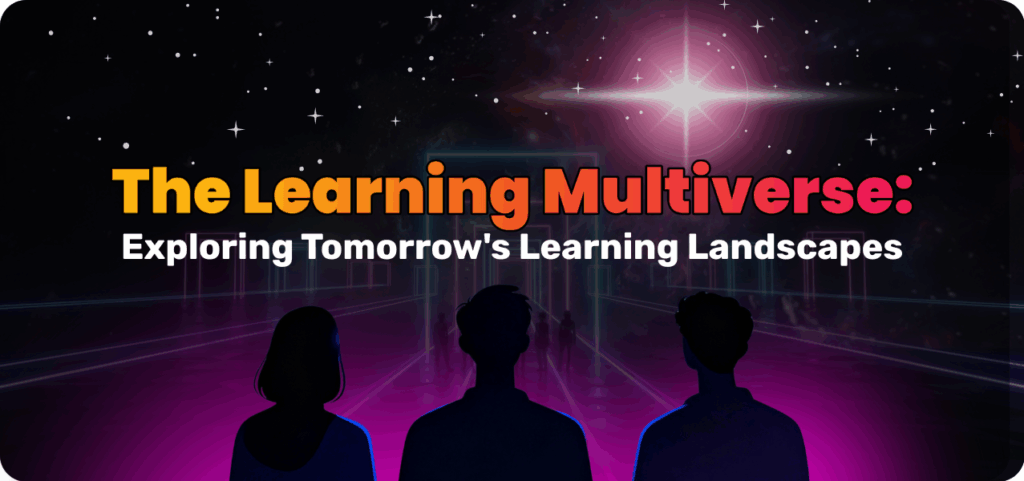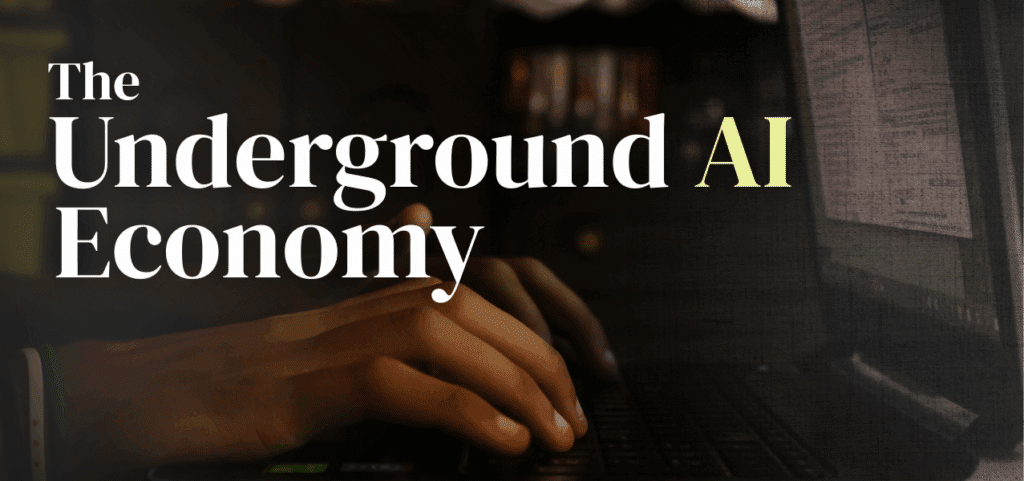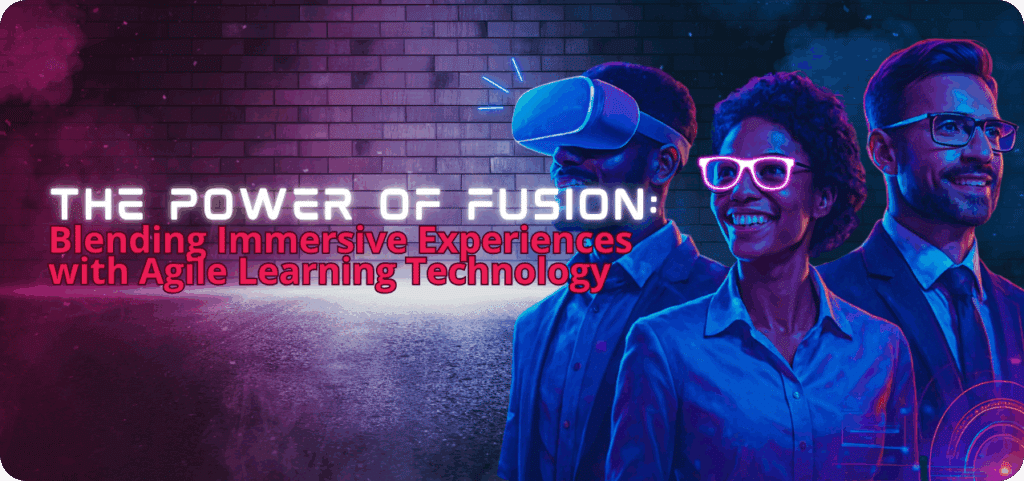The Learning Multiverse: Exploring Tomorrow’s Learning Landscapes

By WDHB & TTRO
Where do Massive Multiplayer Online Games (MMOGs), AI, and reality-altering technologies intersect with learning?
L&D practitioners have long understood that participants who truly experience a program learn more effectively than they would via more traditional methods, like classroom learning. For this reason, talent development teams often choose to send their executives and other professionals to innovative companies, historic sites, and high-performance environments to shape their perspectives with insights from recognised leaders. But in the past two decades, researchers have studied how nontraditional learning environments, such as online games, can develop the learner’s problem-solving skills and take them into real life.
Now, as we enter the second quarter of the 21st century, WDHB and TTRO are pioneering how increasingly intelligent digital technologies can bring results that, like in-person experiences, can enhance learning programs in ways never before seen in leadership development. Our partnership with TTRO envisions these new technologies, when designed with an intentional L&D strategy, as a unique solution that will take executives and emerging leaders to not just one, but many worlds of experiential learning.
As our research and development teams leverage new and emerging technologies, we examine how online gaming has already influenced L&D.
The Gamified Learning Experience
In 2011, researchers Iro Voulgari and Vassilis Komis examined how learning communities form and operate in their article, Collaborative Learning in Massively Multiplayer Online Games: A Review of Social, Cognitive and Motivational Perspectives.
Part of the larger multidisciplinary handbook by Patrick Felicia, the research by Voulgari and Komis’s work shows that players of MMOGs (and the subcategory MMORPGs, or Massive Multiplayer Online Role-Playing Games) form relationships and communities to overcome problems that cannot be solved alone.
They encourage collective problem-solving through quests and interactive challenges, stimulating critical thinking and adaptability. These games foster collaborative learning through stable communities (often called “guilds”) that enable knowledge-sharing and mutual support.
With in-game systems like experience points and level-ranking, the researchers observed how these online games can mirror real-life learning environments. Gradual progression systems and social rewards (such as status and public recognition) strengthen long-term motivation and engagement.
They note that MMOG “features such as motivation, collaboration, player-control, interaction with others, goal-oriented tasks, progress in the environment, individualized navigation based on the level of the player and his or her choices, very often come up as features of an effective collaborative learning environment.”
When online gaming evolved to include MMOGs, researchers observed how players from different cultural backgrounds and demographics came together to achieve common goals — and, in doing so, organically formed learning communities.
For example, the widely-acclaimed Elden Ring by From Software encourages players to help each other understand and practice meta-strategies to overcome extremely difficult challenges. Gamers learn to beat large bosses, clear enemy camps, and access hidden dungeons in ways that are far more difficult to do on one’s own, illustrating how, as Voulgari and Komis say, “Co-operation emerges as an integral part of the attainment of the objectives.”
Learning is reinforced by immediate feedback and dynamic interaction, supporting active and experiential learning. To us, the takeaway is clear: belonging to a valued group boosts self-efficacy — a critical component of problem-solving — and accountability in the learning journey.
For corporate learning, integrating these mechanisms means designing programs built on genuine collaboration, visible progression, and sustainable motivation driven by the community. This is what we call “gamified learning”, where L&D research and design teams can bring the high-engagement components of MMOGs and other video games to their leadership development.
The research into gamified learning continues with the more recent Gamification in Online Adult Learning: A Systematic Literature Review by Apostolos Kostas, George Koutromanos, and Ioanna Lagopati. The study shows that gamification offers significant potential for enhancing motivation, engagement, and learning in various key areas, including formal education in higher education, corporate training, healthcare, workplace settings, and sustainability.
According to this research, gamified learning may even answer a common business problem in L&D: wasted training. When compared with classroom learning or other traditional formats, Kostas, Koutromanos, and Lagopati observe how ”traditional methods can result in reduced motivation, lower engagement, and decreased knowledge retention among adult learners.”
Although experiential learning programs (when designed correctly) inherently address these L&D challenges, we are looking to expand our immersive program designs with TTRO to bring the benefits of gaming to the executive suite. The researchers note that gamification “aligns well with adult learners’ expectations for engaging, flexible, and self-directed learning experiences” that supports “learners’ intrinsic motivation, engagement, and self-efficacy — critical factors for sustained lifelong learning.”
Kostas, Koutromanos, and Lagopati also note how problem-solving as a community within a game enables people to tackle challenges in the workplace: “Research has shown that gamification can also be utilized in work environments to enhance employee efficiency and productivity. Cooperative learning in gamified educational contexts helps learners develop their communication and collaboration skills to address practical problems together.”
Their observations are clear: “gamification can also be applied in work environments to enhance employee efficiency and productivity.”
In examining both experiential programs and emerging technologies, WDHB and TTRO recognise how prior research illustrates the power of gamification in corporate learning. While our partnership will bring these benefits to our clients, we also envision how gaming itself — powered by new technologies like VR — can become an immersive extension of experiential learning, engaging employees like never before.
So, where do we go from here?
Looking Forward: Bringing Immersive Technology Into Experiential Learning
In McKinsey’s Technology Trends Outlook 2025, authors Lareina Yee, Michael Chui, Roger Roberts, and Sven Smit discuss the most strategic technologies to transform the corporate learning landscape in the next five to ten years:
- Advanced AI (generative & agentic) to personalize, automate, and enrich learning journeys.
- Powerful infrastructure and ultra-fast connectivity to make immersive experiences accessible and reliable.
- XR and intelligent interfaces to make learning more interactive and engaging.
- Technological security and trust as essential drivers of adoption.
- Controlled scalability in a dynamic, globally competitive environment.
But how do we plan to build these strategic technologies into experiential learning programs?
Bespoke Programs Powered by AI
We aspire to use technology to empower an all-encompassing L&D strategy. While we customise learning programs to match each client, artificial intelligence can take this a step further and create learning materials tailor-made for participants at the individual level.
Immersion through Digitally-Enhanced Realities
We imagine a learning program that can blend our standard components — historic sites, innovative company visits, and intimate Q&A panels with leaders — with the latest Augmented Reality (AR), Extended Reality (XR), and Virtual Reality (VR) technologies. Imagine, for instance, a version of our Gettysburg Leadership Experience program where participants not only visit the actual battlefield and talk with historians, but they will also, through VR and AI simulation, “see” and “hear” President Abraham Lincoln deliver the Gettysburg address. With these new technologies, the learning possibilities are endless. WDHB and TTRO aim to harness them to shape the future of leadership development.
Maintaining the Fundamentals
Regardless of the unknown ways that technology will shape the future, we understand the future of learning will evolve in smart, immersive, and socially-driven ecosystems — where technology does not replace human connection, but expands it. In moving forward, we will continue to apply the research, insights, and methodologies we have learned since 1989 and 2008 — the years that WDHB and TTRO, respectively, began to pioneer the future of L&D. With our combined fifty-three years of leadership experience powered by revolutionary technologies, leadership development is, for the first time in history, capable of bringing imagined realities into experiential learning.
And now we ask you to imagine the most transformational learning program for your organisation. What would it look like?
With AI, XR, and these other groundbreaking technologies, we can unify even the most imaginative program content with what we do best: experiential learning.
Together — between TTRO, WDHB, and you — we can bring your program to life. Start the conversation and we will make it happen.
Sources
- Voulgari, Iro & Komis, Vassilis. (2011). “Collaborative Learning in Massively Multiplayer Online Games: A Review of Social, Cognitive and Motivational Perspectives.” 10.4018/978-1-60960-495-0.ch018.
- KOSTAS, Apostolos & Koutromanos, George & Lagopati, Ioanna. (2025). “Gamification in Online Adult Learning: A Systematic Literature Review.” Journal of Information Technology Education: Research. 24. 022. 10.28945/5549.
- “McKinsey Technology Trends Outlook 2025” by Lareina Yee, Michael Chui, Roger Roberts, and Sven Smit. Copyright © McKinsey & Company. Designed by McKinsey Global Publishing
Author
Subscribe to get Access to Exclusive Content





